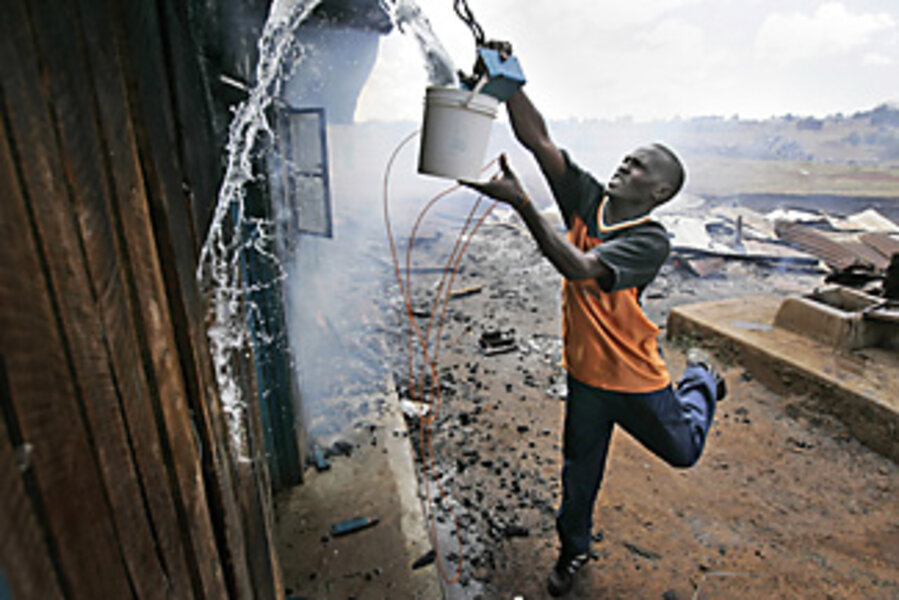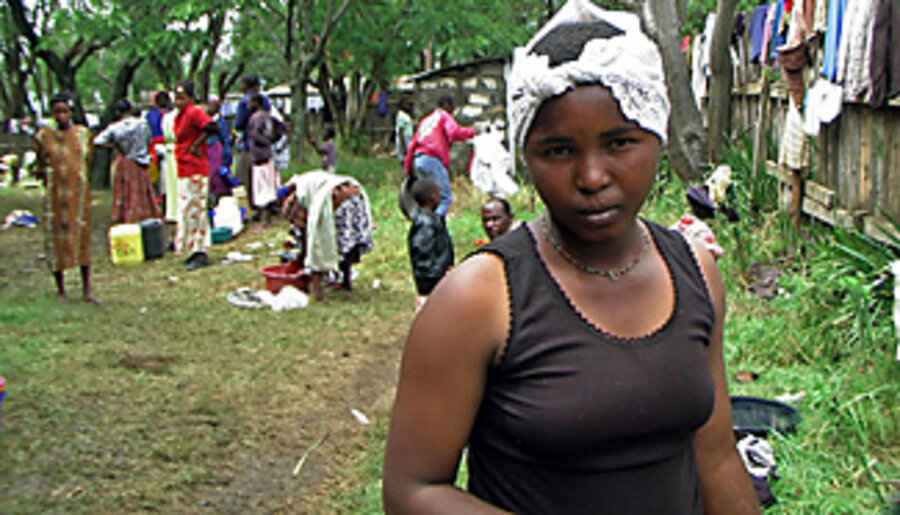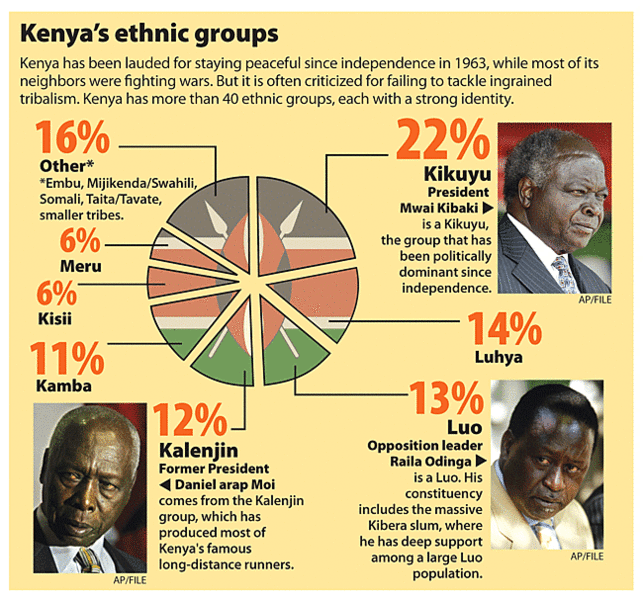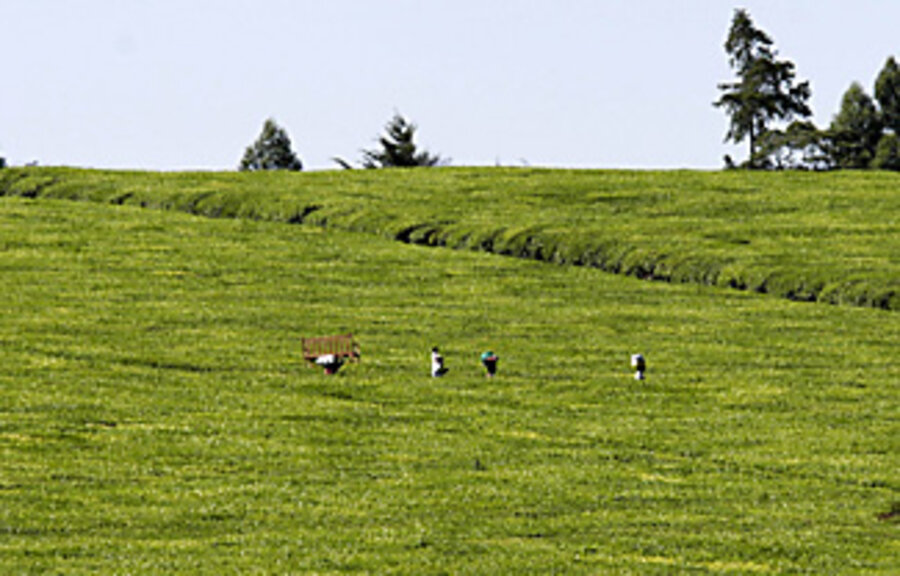How Kenya came undone
Loading...
| Nakuru, Kenya
They came at night by the hundreds, shooting villagers with arrows and attacking them with knives, hatchets, and farm tools. The killings were a warning to the rest of the village: Leave now, or die.
"These people were our neighbors, I knew them, but what I have seen is something that I cannot explain," says Julia Muthoni, an elderly widow who found refuge in the city of Nakuru. "The problem is that we Kikuyus are being targeted because we voted for the reelection of President Mwai Kibaki. Even before the election, they were threatening us saying that whether Kibaki wins or not, Kikuyus are going to be evicted."
Just a few weeks ago, Kenya remained an oasis of stability surrounded by nations at war. The tourist-friendly country is East Africa's economic engine, a hub for global trade, and a base for international humanitarian work. It has been a been a model of what other African countries could achieve if they worked hard, developed their economies, and embraced free democracy. So the explosion of violence that has left more than 750 people dead – including more than 100 in the past few days – and forced a quarter-million to flee their homes since the disputed Dec. 27 presidential election came as a shock to many. But under the placid surface, Kenya boils with deep ethnic resentment that some observers say has been ignored for too long.
"The matchbox was lit [by the vote], but the fuel was already there," says Njeri Kabeberi, a political analyst and head of the Center for Multiparty Democracy in Nairobi. "There has always been ethnic tension within Kenyan society that has never truly been removed or dealt with."
While the most recent spark for the violence was the deeply flawed elections in which Mr. Kibaki was declared president, the underlying source of the country's tension is a perception that one ethnic group – Kibaki's Kikuyu tribe – has unfairly benefited from the nation's wealth solely because of its proximity to people in power. Resentment between Kenya's ethnic communities is chronic, observers say, but mistrust of Kikuyus has been building ever since Kenya's first president, Jomo Kenyatta, took power after independence from Britain in 1963.
Under Mr. Kenyatta – himself a Kikuyu – Kikuyus rose to high positions in government, took over major firms, and bought much of the farm land sold off by departing white settlers in the fertile Rift Valley. But it took a sense of betrayal to produce the violence of today, experts say. In 2002, a remarkably broad coalition of opposition leaders from different ethnic groups overthrew the 24-year dictatorship of President Daniel arap Moi. The new government signed a memorandum of understanding to share power.
But in 2003, Kibaki revoked that agreement and went back to the old habit of filling government positions – including, crucially, the Electoral Commission of Kenya – with personal allies and members of his own ethnic group, the Kikuyus. Furious at what they considered a betrayal, and cut off from access to power, former allies such as populist opposition leader Raila Odinga – a member of the Luo ethnic group who claims that he won the Dec. 27 vote – broke from the government and started a campaign for "majimbo," Swahili for self-rule, and resistance to Kikuyu domination.
"The fact that this violence was going to happen wasn't a surprise," says Waiganjo Kamotho, an attorney and political observer in Nairobi. "For months out in the Rift Valley, we've been hearing people saying "nyorosha," which means, 'We're going to straighten you up, put you in your place.' "
In the election, voters cast ballots along ethnic lines. Kibaki's support came from Kikuyus. Mr. Odinga, a Luo, drew mainly from his Luo tribe, but a coalition of politicians from smaller ethnic groups added to his base.
For most Kenyans, this tribal fight is not just about the presidency, but land – the ultimate source of wealth in a mainly agricultural society. And the Rift Valley – Kenya's bread basket – is the main battlefield, as small "indigenous" armies with bows, arrows, and machetes march to expel the Kikuyu "newcomers."
"In Kenya, the state has a lot of ability to allocate land, which is a major source of wealth," says Jacqueline Klopp, an Africa expert at Columbia University in New York. Referring to past presidents Kenyatta, a Kikuyu; Mr. Moi, a Kalenjin; and Kibaki, a Kikuyu; she adds, "Kenyatta and Moi did it. Kibaki was a little better, but all allocate land and use it for political patronage."
Under strong-arm leaders such as Kenyatta and Moi – both of whom controlled all branches of government and stifled the media – this cozy relationship between presidents and their tribes caused little violence. Kikuyus bought land in the ancestral areas of the Kalenjins, the Maasais, the Luos, and other tribes, set up trading businesses and prospered. But when Moi bowed to pressure to allow a multiparty system, opposition politicians used the success of the Kikuyu "settlers" against them. In Kalenjin areas, Kalenjin politicians built up their own base of support by feeding resentment toward Kikuyus, calling them "settlers" who had used their connections to the government to "steal" their ancestral lands.
Some politicians used radio broadcasts to spread hatred against Kikuyus, and proclaimed that the time had come to remove the "weeds" from their lands.
Stoked with hate, the ethnic clashes began in earnest, particularly in the areas where Kikuyus had settled in the Rift Valley. Between the elections of 1992 and 1997, more than 2,000 Kenyans were killed and more than 300,000 Kenyans were displaced, most of them Kikuyus.
"Kikuyus are the business community and they are happy when things are not shaken," says Ms. Kabeberi, herself a Kikuyu. "The Luos are like the Zulu community in South Africa. They will go to war for any reason. So you have to be sure you don't give them a reason."
The 'haves' against the 'have-nots'
Politicians have used the belief that Kikuyus control the economy as a battle cry, pitting Kikuyus as the perpetual "haves" against the Luos, Kalenjins, and other tribes as the perpetual "have-nots." Odinga has primed those feelings with a call for majimbo which, for many non-Kikuyus, means each tribe should return to its own ancestral land.
"The Kikuyus are greedy," says a Luo security guard named Innocent. "Who owns all the big businesses? Kikuyus. Who owns all the big farms? Kikuyus. And who are all the top leaders in Kibaki's government? Kikuyus. So when they go into our land and take our property, people are going to push back. It's our turn."
Kikuyus view majimbo as a danger to the future of the country. "The Luos are lazy," says one Kikuyu taxi driver named Johnson. "They don't invest. They don't create. They don't know how to run a business. And now look at the violence they are creating. Do you think these people should be running this country?"
This year, the violence has spread far beyond the Rift Valley into almost every urban center, tearing the social fabric of a cosmopolitan society that had made Kenya a regional economic force. Most foreign tourists have canceled vacations this winter, Kenya's peak season. The Central Organization of Trade Unions estimates that nearly 500,000 workers will lose their jobs.
"They have basically destroyed the local trade, and now that they can't buy food in the market, they are discovering to their shock and horror that they need each other," says Richard Cornwell, a senior analyst at the Institute for Security Studies in South Africa.
Kenya's current movement into a society of ethnic enclaves is a form of apartheid, Mr. Cornwell says. "In 20 or 30 years' time, this will be a powder keg. It's like what we saw in Northern Ireland between Protestants and Catholics; like Burundi and Rwanda. Unless this is handled, this will be a slow civil war that doesn't really break out, but it's insidious. It's always there."
A slow-burning civil war?
In the town of Nakuru, Keffa Magenyi Karuoya already feels the effects of that slow civil war. Since 1991, he has been displaced three times, including by this year's election violence. A Kikuyu himself, he has been working with a network of community activists from different tribes in the Rift Valley to advocate for peace, and to seek food aid and shelter for newly displaced victims.
"It is very frustrating," says Mr. Karuoya. The people coming from Eldoret now, they can't go back." Eldoret is the mainly Kalenjin town where a church full of Kikuyus was burned two weeks ago, killing at least 30 people. But Kikuyus are not the only victims, he adds. "Just down the road, there are 3,000 Luo families camping out. The long-term issue, where this is going, that is my main concern."
A phone call disrupts Karuoya's train of thought. An activist in a nearby town warns of armed groups moving in to surround three small camps of Kikuyus. One of the camps is in a monastery, surrounded by 1,500 people armed with bows, arrows, and spears. Local police are nowhere to be found.
"There's an impending massacre," Karuoya says after ending the call. He leaves the room to call up the district commissioner, the provincial police officer – anyone who can give orders to send troops and stop a massacre.
An activist in Kuresoi tells the Monitor by cellphone that the government must move fast to evacuate the Kikuyus. "The youth here seem decided to start invading the camps," she says, speaking on condition of anonymity. "I can't believe this is happening. I can't even sleep at night. I keep trying to harmonize the two communities." Her voice breaks. "I am trying to see the way forward."
By next morning, the death tolls from Kuresoi district start to come in. In one camp, where 600 individuals are sheltered in a monastery, six people have been killed by arrows and machetes. More than a dozen are injured.
Kikuyus are now carrying out reprisal killings. On Jan. 20, members of the Mungiki sect – a militia formed to protect Kikuyu interests – swept through the Nairobi slum of Mathare attacking non-Kikuyus.
Musalia Mudavadi, an opposition parliamentarian, blamed the police for failing to control the Mungikis. "Today, some of our leaders have been appealing for calm, but the government has not withdrawn the ban on the right to assemble, the right to talk, and they have not withdrawn the shoot-to-kill order."
• How can Kenya avoid ethnic war? Read Part 2 tomorrow.








